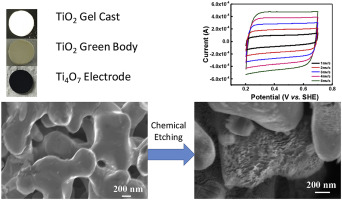Electrochimica Acta ( IF 5.5 ) Pub Date : 2018-01-08 , DOI: 10.1016/j.electacta.2018.01.034 Sasmita Nayak , Brian P. Chaplin

|
Highly porous and conductive monolithic electrodes have found various electrochemical applications in water treatment and energy storage and conversion. In this work we have successfully synthesized monolithic Ti4O7 electrodes by two production methods—mechanical pressing of Ti4O7 powders and gel casting of TiO2 powders followed by sintering and reduction to Ti4O7. The electrodes were characterized by X-ray diffraction (XRD), Hg porosimetry, scanning electron microscopy, thermal gravimetric analysis, Mott-Schottky analysis, and sweep voltammetry. The removal of oxygen atoms from the TiO2 precursor resulted in n-type doping behavior, and XRD measurements confirmed the electrodes consisted of high purity Ti4O7. Porosimetry analyses indicated the electrodes had high porosities (44–48%) and low bulk densities (∼2.0 g cm−3), which allowed for high permeate fluxes of up to 801 ± 81 LMH bar−1, when operated in a flow-through mode. The efficient mass transfer achieved in the porous electrodes resulted in high rate constants for the oxidation of Fe(CN)64− (kobs = 3.0–4.5 × 10−4 m s−1). The electrodes also showed high rates of removal for oxalic acid and terephthalic acid, which were probes for direct oxidation and OH production, respectively. Chemical etching of the electrodes increased the electroactive surface area by approximately 2-fold, which increased the capacitance (30 mF cm−2) and reactivity of the electrodes towards outer sphere electron transfer reactions and the production of OH
by the same factor. These results indicated that the Ti4O7 monolithic electrodes could enhance charge transfer reactions in various electrochemical applications.
中文翻译:

多孔导电单片Ti 4 O 7电极的制备和表征
在水处理以及能量存储和转换中,高度多孔且导电的整体式电极已经发现了各种电化学应用。在这项工作中,我们通过两种生产方法成功地合成了整体式Ti 4 O 7电极:机械压制Ti 4 O 7粉末和凝胶铸造TiO 2粉末,然后烧结并还原成Ti 4 O 7。通过X射线衍射(XRD),汞孔隙率法,扫描电子显微镜,热重分析,莫特-肖特基分析和扫描伏安法对电极进行表征。从TiO 2中去除氧原子前驱体导致n型掺杂行为,XRD测量证实电极由高纯度Ti 4 O 7组成。孔隙率分析表明,该电极具有高孔隙率(44–48%)和低堆积密度(〜2.0 g cm -3),当在流动条件下操作时,允许的渗透通量高达801±81 LMH bar -1。通过模式。在多孔电极中实现的有效质量转移导致Fe(CN)6 4−(k obs = 3.0–4.5×10 -4 m s -1的氧化的速率常数高)。电极还显示出对草酸和对苯二甲酸的高去除率,草酸和对苯二甲酸分别是直接氧化和OH生成的探针。电极的化学蚀刻将电活性表面积增加了约2倍,从而以相同的因素增加了电容(30 mF cm -2)和电极对外球电子转移反应和OH
的反应性。这些结果表明,Ti 4 O 7整体电极可以在各种电化学应用中增强电荷转移反应。











































 京公网安备 11010802027423号
京公网安备 11010802027423号